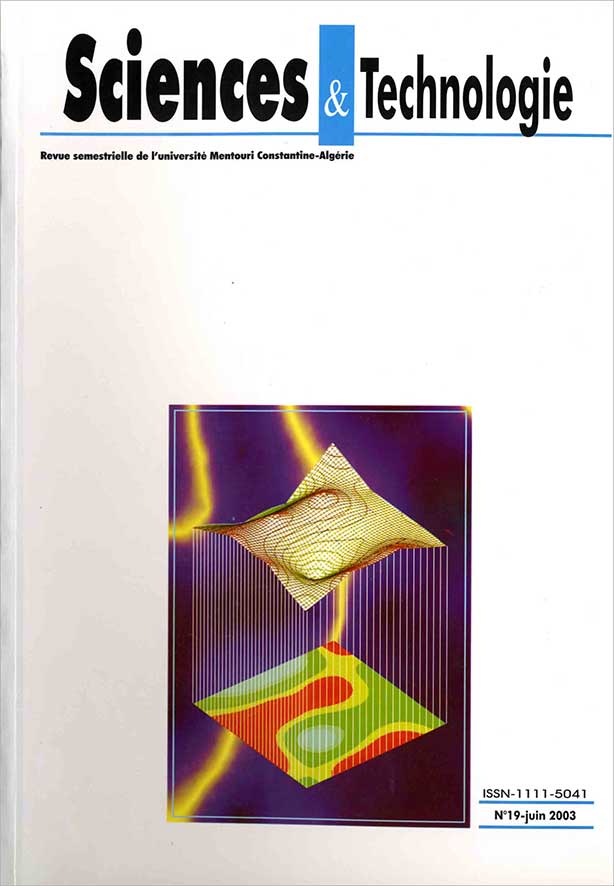UNE APPROCHE QUALITATIVE SUR LE TRAITEMENT DE L’INCERTAIN: APPLICATION AU SYSTEME EXPERT
Keywords:
Incertitude qualitative, systèmes experts, probabilité symbolique, représentation des connaissances, logique multivaluéeAbstract
Nous présentons un système expert de classification automatique supervisé basé sur une approche symbolique. Ce dernier est constitué de deux sous-systèmes. Le premier sous-système génère automatiquement les règles de production à partir d'un ensemble d'apprentissage; les règles générées sont pondérées par un degré de croyance symbolique qui caractérise leurs classes d'appartenances. Le deuxième est le système d'inférence qui reçoit en entrée la base de règles et l'objet à classer; ensuite, à l'aide du raisonnement classique (le Modus Ponens) il fournit la classe d'appartenance de cet objet avec un certain degré de croyance symbolique. Les méthodes d'évaluation du degré de croyance sont nombreuses, mais souvent entachées d'incertitudes. Pour apprécier les performances de notre approche symbolique, nous avons effectué des tests sur deux images: la cryosection de la cuisse humaine et de la texture.Downloads
References
- Borgi A. "Apprentissage supervisé par génération de règles: le système SUCRAGE"ة Thèse de l’Université de Paris 6, (1999).
- Ishibuchi H., Nozaki K., Tanaka H., "Distributed representation of fuzzy rules and its application to pattern classification", Fuzzy Sets and Systems, North-Holland, Vol. 52, (1992), pp. 21-32.
- Ishibuchi H., Nozaki K., Yamamoto N., Tanaka H., "Construction of fuzzy classification systems with rectangular fuzzy rules using genetic algorithms", Fuzzy Sets and Systems, North-Holland, Vol. 65, (1994), pp. 237-253.
- Ishibuchi H., Nozaki K., Yamamoto N.,Tanaka H., "Selecting Fuzzy If-Then Rules for Classification Problems Using Genetic Algorithms", IEEE Transactions on Fuzzy Systems, Vol. 3, N°3, August (1995).
- Nozaki K., Ishibuchi H., Tanaka H., "Selecting Fuzzy Rules with Forgetting in Fuzzy Classification Systems", Proceedings of the Third IEEE International Conference on Fuzzy Systems, Orlando, Vol. 1, (1994), pp. 618-623.
- Ishibuchi H., Nozaki K., Tanaka H., "Efficient fuzzy partition of pattern space for classification problems", Fuzzy Sets and Systems, North-Holland, Vol. 59, (1993), pp. 295-304.
- Zighed D.A., Auray J.P., Dura G., "SIPINA: Méthode et logiciel", Editions Alexandre Lacassagne, Mathématiques appliquées, N°2, (1992).
- Quinlan J.R. "Learning efficient classification procedures and their application to chess and games", in: R.S. Michalski, J.G. Carbonell et T.M. Mitchell editors, Machine Learning: An Artificial Intelligence Approach. Morgan Kaufman Publishers, Vol.1, (1983), pp. 463-482.
- Quinlan J.R., "Improved Use of Continuous Attributes in C4.5", Journal of Artificial Intelligence Research, 4, (1996), pp. 77-90.
- Breiman L., Friedman J.H., Olshen R.A., Stone C.J., "Classification and regression trees", Chapman and Hall, (1984).
- Marsala C., "Apprentissage inductif en présence des données imprécises: construction et utilisation d'arbres de décision flous", Thèse de Doctorat de l'Université Paris 6, janvier (1998).
- Vernazza G., "Image Classification By Extended Certainty Factors", Pattern Recognition, Vol. 26, N° 11, Pergamon Press Ltd, (1993), pp.1683-1694.
- Borgi A., Bazin J. M., Akdag H., "Supervised Classification by Automatic Rules Generation", The Fourth World Congress on Expert Systems, Application of Advanced Information Technologies, Mexico City, (1998), pp. 561-568.
- Seridi H., Bannay-Dupin F., Akdag H., "Qualitative operators for dealing with uncertainty", Proceeding of Fuzzy-Neuro Systems’98, Computational Intelligence, Edited by C. Freksa, infix, (1998), pp. 202-209.
- Seridi H., Akdag H., "Le traitement de l’incertain par une approche qualitative", Proceedings of IPMU’98, Paris, (1998), Vol. 2, pp. 1684-1690.
- Seridi H., Akdag H., "A Qualitative Approach for Processing Uncertainty", in: Uncertainty in Intelligent and Information Systems, Edited by B. Bouchon-Meunier, R.R. Yager and L.A. Zadeh in: Advances in Fuzzy Systems-Applications and Theory, World Scientific, Vol. 20, (2000), pp. 46-57.
- Pearl J., "Numerical Uncertainty In Expert Systems", Readings in Uncertainty Reasoning, Edited by G. Shafer and J. Pearl, Morgan Kaufman publishers, Inc. California, (1990), pp. 255-258.
- Heckermans D., "Probabilistic Interpretations for MYCIN's Certainty Factors", Uncertainty in Artificial Intelligence, L.N. Kanal & J.F. Lemmer (Editors), North-Holland, (1986), pp. 167-196.
- Zadeh L., "Fuzzy Sets as a Basis for a Theory of Possibilty", Fuzzy Sets and Systems, 1, North-Holland Publishing company, (1978), pp. 3-28.
- Kohavi R., "A Study of Cross-Validation and Bootstrap for
Accuracy Estimation and Model Selection", Proceedings of fourteenth International Joint Conference on Artificial Intelligence, Canada, Vol. 2, (1995), pp. 1137-1145.
- Ould Ahmedou M.L., Bonnet N., "Etude comparative de différentes méthodes de classification non supervisée. Application à la segmentation d'images multivariables", Proceedings of IPMU’98, Paris, Vol. 2, (1998), pp. 1677-1683.







